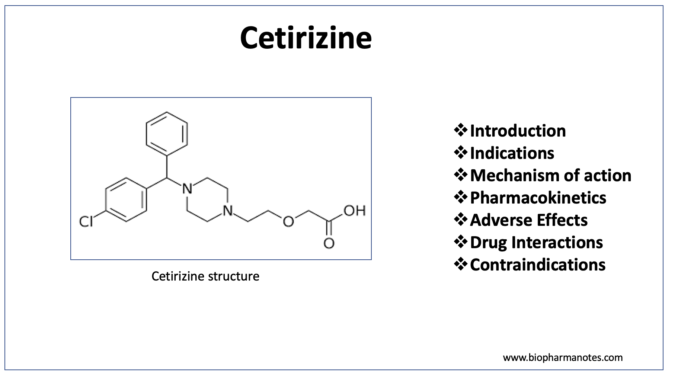
- Cetirizine is one of the first second- generation, selective histamine (H1) receptor antagonist. It is derived from first generation antihistaminic drug, hydroxyzine. Cetirizine is a synthetic phenylmethyl- piperazinyl derivative and chemically belongs to the class of piperazines.
- Available as generic medicine nowadays.
Some available brands
Zyrtec, Aller-tec, Alleroff
Indications of cetirizine
- It is common drug used to treat allergic rhinitis. It helps to relieve sneezing, watery eyes, redness of eyes and rhinorrhea associated with perennial allergic rhinitis (due to allergens like dust, animal dander and molds) or seasonal allergies caused due to grass and tree pollens.
- Used in treating chronic urticaria. It helps to reduce severity, occurrence, and duration of hives and pruritus associated with idiopathic urticaria.
Mechanism of action of cetirizine
- Cetirizine is highly selective antagonist of peripheral H1 receptors. H1 receptors are mostly present in neuronal system, smooth muscles, immune cells, and endothelium. Activation of H1 receptors by histamine may cause itching, pain, hypotension, tachycardia, cough, bronchoconstriction, and increased permeability.
- Cetirizine mostly antagonizes H1 receptors present in immune cells, endothelium and immune cells and reverses the effect of histamine resulting in decreased vascular permeability, inhibition of histamine induced bronchospasm and decrease in amount of fluid escape from tissue to capillaries.
- It doesn’t cross blood brain barrier in large extent unlike first generation antihistamines. Hence, it doesn’t have much effect on H1 receptors present in neurons and produces minimum sedation.
Pharmacokinetics of cetirizine
- It is administered by oral route and is absorbed rapidly in GI tract after oral administration. Peak plasma concentration is achieved after around one hour of administration. Its dose depends on the age of patient. It is available as tablet or syrup form.
- Its action begins after 20-60minutes of administration and lasts for at least 24 hours. Around 93% of the administered drug binds to plasma proteins. It is metabolized partially by oxidative O-dealkylation.
- It is excreted largely unchanged via urine. Its elimination half-life is around 8.3 hours.
Missed Dose
- If you miss the dose of cetirizine, take the missed dose as soon as you remember about it. But if it already is time for next dose, skip the missed dose and continue with your regular dosing schedule.
- Avoid taking two doses at a time to make up for the missed dose.
Adverse effects
- It is safe and well tolerated drug. Most common adverse effect associated with cetirizine is headache. It can also cause dry mouth, fatigue, and sedation.
- Compared to other second generation H1 antihistamines including fexofenadine and desloratadine, it produces higher extent of drowsiness.
Drug Interactions
- Concurrent administration of cetirizine with drugs which cause drowsiness including alcohol, opioids (codeine, morphine), drugs for sleep or anxiety (e.g., zolpidem, lorazepam), other antihistamines or muscle relaxants like carisoprodol may potentiate the sedative effects.
- Action of cetirizine is very similar to levocetirizine and hydroxyzine. So, it should not be used with these drugs.
Contraindications
- Contraindicated in patients with known hypersensitivity to cetirizine or any other components of the formulation.
- Contraindicated in patient with known hypersensitivity to hydroxyzine.
- It is pregnancy category B drug and is used in pregnancy only when absolutely required. It’s use in nursing mothers is not recommended as it gets excreted in breast milk.
Storage
- Both tablet and liquid form should be stored in room temperature in dark and dry place. Should be kept out of reach of children.
References
- https://www.ncbi.nlm.nih.gov/books/NBK549776/
- https://go.drugbank.com/drugs/DB00341
- https://go.drugbank.com/articles/A175054
- Zhang L et al. The Clinical use of Cetirizine in the Treatment of Allergic Rhinitis. Pharmacology. 2013; 92: 14-25.
- Pharmacology and Pharmacotherapeutics. 24th edition.
- Goodman and Gillman Manual of Pharmacology and Therapeutics.
- Lippincott Illustrated Reviews Pharmacology, 6th edition.
- Essentials of Medical Pharmacology. 7th edition.